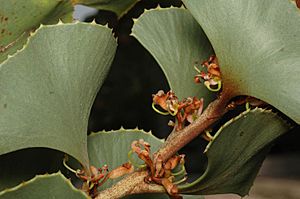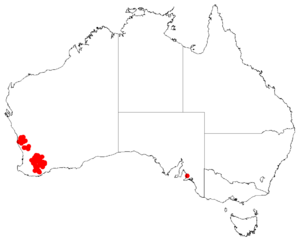Hakea brownii facts for kids
Quick facts for kids Hakea brownii |
|
|---|---|
 |
|
| Hakea brownii in the ANBG | |
| Scientific classification | |
| Genus: |
Hakea
|
| Species: |
brownii
|
 |
|
| Occurrence data from Australasian Virtual Herbarium | |
The Hakea brownii, also known as the fan-leaf hakea, is a cool shrub that belongs to the Proteaceae plant family. You can find it growing naturally in the Wheatbelt area of Western Australia. This plant shares its common name with another plant, Hakea baxteri, because both have unique fan-shaped leaves.
Contents
What Does the Fan-Leaf Hakea Look Like?
The Hakea brownii is a shrub that can grow from about 0.4 to 2.5 meters (1.3 to 8.2 feet) tall. It has a special woody swelling underground called a lignotuber. This helps the plant regrow after fires or other damage.
When the plant is young, its smaller branches and new leaves are covered in soft, rusty-colored hairs. As the plant gets older and starts to flower, these hairs disappear, and the branches become smooth.
Its leaves are really interesting! They are shaped like a fan, feel stiff and thick, and have prickly teeth at the top. The sides of the leaves are straight, getting narrower towards the bottom. They are usually 2.8 to 6.5 centimeters (1.1 to 2.6 inches) long and 2 to 6 millimeters (0.08 to 0.24 inches) wide.
Flowers and Fruit
The Hakea brownii produces small, sweet-smelling flowers. There are usually 6 to 10 cream-brown flowers in each cluster. These flower clusters grow in the leaf corners or on older parts of the plant. You can see them blooming from August to November.
The stalks that hold the flowers, called pedicels, are 2 to 6 millimeters long. They are covered in thick, rusty-colored hairs, which also extend onto the lower part of the flower. The main part of the flower, the perianth, is 5 to 7 millimeters long, and the style (a part of the flower's reproductive system) is 7 to 9 millimeters long.
After flowering, the plant grows large, round, egg-shaped fruits. These fruits are 3.5 to 5 centimeters (1.4 to 2 inches) long and 4 to 4.5 centimeters (1.6 to 1.8 inches) wide. The outside of the fruit looks wrinkled and might have a network of veins, ending in a short, pointed tip.
How Was Hakea brownii Named?
The Hakea brownii was first officially described by a scientist named Carl Meisner in 1845. He published his findings in a book called Plantae Preissianae.
The plant was named after Robert Brown, who was a famous botanist and the librarian of the Linnean Society of London.
Where Does the Fan-Leaf Hakea Grow?
You can find the Hakea brownii in many places across Western Australia. It grows from the coastal areas near the Murchison River all the way through the central wheatbelt region to Cape Riche.
This plant prefers to grow in sandy soil, deep sand, or sand that sits over a type of rock called laterite. It likes areas with heath (low-growing shrubs) or shrubland. For it to grow well, it needs a spot where the water drains away easily and where it gets plenty of sunshine. It can also handle frost, which means it can survive in colder temperatures. People sometimes use its beautiful flowers in art, and it provides a good home for wildlife.
Is Hakea brownii Endangered?
Good news! The Western Australian Government currently considers Hakea brownii to be "not threatened." This means it's not at risk of disappearing.

